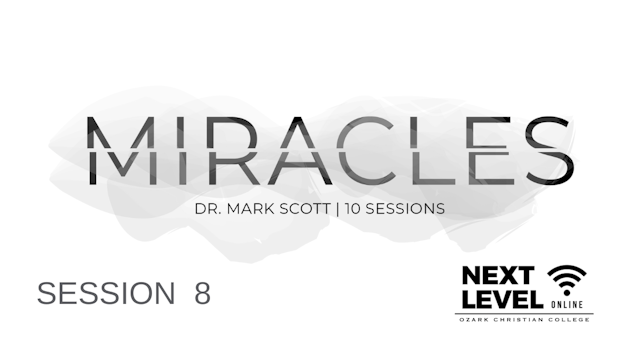The Intensification and Distinctives of the Miracles of Jesus


The vision of Ozark Christian College is to glorify God by evangelizing the lost and edifying Christians worldwide. The mission of Ozark Christian College is to train men and women for Christian service as a degree-granting institution of biblical higher education.
In this lesson we want to develop the themes of intensification and distinctives of the miracles of Jesus.
We mentioned in an earlier lesson that the miracles of the Bible often come to us in clusters—creation, the exodus, etc. The same is often true when they are presented to us in the Gospel record. When that happens we might look for…
Intensification:
This could be an intensification of theme, of conflict, or of identity
In parable study the scholars speak of end stress. This means that the accent of an individual parable is on the last part OR it can refer to a series of parables with the accent following on the last one (e.g. Lk. 15).
This may be easier to illustrate than to define. Matthew is especially prominent in this regard (Matt. 8-9, 21-22). But I would like to consider Mark’s Gospel:
The accent falls on the last one. If he can handle storms and the spirit world, he can probably handle my biggest issue, i.e. illness and death.
Distinctives:
This matters more than one thinks at first pass. Why do certain Gospels contain certain miracles? Why are some miracles unique to that Gospel? How does the literary context of the Gospel writer play into this?
Let me give the hints or clues to look for behind some of this and move to a few examples.
of Jn. and 20:30-31; Mk. 8:22-26, “Seeing Double” as the “blind” narratives follow the boat and bread narratives.
Read vertically and horizontally when reading the Gospels. Sometimes the distinctives are found when comparing accounts.
Watch for intensification—already mentioned.
Pay attention to keywords—“immediately” in Mk.
Since the genre is narrative watch for normal narrative things, e.g. plot, people, places, dialogue, disequilibrium and denouement.
Three examples:
Now I would like to help you with miracles in each Gospel:
Matthew:
Mark:
Luke:
John:
In this lesson we want to develop the themes of intensification and distinctives of the miracles of Jesus.
We mentioned in an earlier lesson that the miracles of the Bible often come to us in clusters—creation, the exodus, etc. The same is often true when they are presented to us in the Gospel record. When that happens we might look for…
Intensification:
This could be an intensification of theme, of conflict, or of identity
In parable study the scholars speak of end stress. This means that the accent of an individual parable is on the last part OR it can refer to a series of parables with the accent following on the last one (e.g. Lk. 15).
This may be easier to illustrate than to define. Matthew is especially prominent in this regard (Matt. 8-9, 21-22). But I would like to consider Mark’s Gospel:
The accent falls on the last one. If he can handle storms and the spirit world, he can probably handle my biggest issue, i.e. illness and death.
Distinctives:
This matters more than one thinks at first pass. Why do certain Gospels contain certain miracles? Why are some miracles unique to that Gospel? How does the literary context of the Gospel writer play into this?
Let me give the hints or clues to look for behind some of this and move to a few examples.
of Jn. and 20:30-31; Mk. 8:22-26, “Seeing Double” as the “blind” narratives follow the boat and bread narratives.
Read vertically and horizontally when reading the Gospels. Sometimes the distinctives are found when comparing accounts.
Watch for intensification—already mentioned.
Pay attention to keywords—“immediately” in Mk.
Since the genre is narrative watch for normal narrative things, e.g. plot, people, places, dialogue, disequilibrium and denouement.
Three examples:
Now I would like to help you with miracles in each Gospel:
Matthew:
Mark:
Luke:
John:

Phone: 918-994-2638 | Email: support@churchapps.org
2025 © Live Church Solutions. All rights reserved.